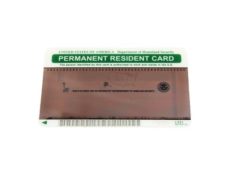
Learning About the Green Card Process: Everything You Need to Know
The United States of America has always been an alluring destination for people from all over the world. The country offers a wealth of opportunities, a vibrant culture, and a quality of life like no other. However, obtaining a green card, which is the first step towards becoming a permanent resident of the United States, is a long and complex process. In this article, we will take a closer look at the green card process and provide you with detailed information on everything you need to know about obtaining a green card.
What is a Green Card?
Before we delve into the green card process, it’s important to first understand what a green card is. A green card is a document that gives immigrants permanent resident status in the United States. Green card holders are allowed to live and work in the United States indefinitely, as long as they follow the rules and regulations set forth by the government.
There are several ways to obtain a green card, including through family sponsorship, employment, or the Diversity Visa Lottery program. No matter how you obtain your green card, you must first apply for it through the U.S. Citizenship and Immigration Services (USCIS).
Types of Green Cards
The USCIS offers several different types of green cards, each with its own set of qualifications and requirements. Here are some of the most common types of green cards:
Family-Based Green Cards: If you have a close family member who is a U.S. citizen or a permanent resident, they may sponsor you for a green card. Spouses, parents, and children are given preference in this process.
Employment-Based Green Cards: If you have a job offer from a U.S. employer or an approved petition from the USCIS, you may be eligible for an employment-based green card. These are divided into five preference categories, with the highest preference given to individuals with extraordinary abilities in their field.
Diversity Visa Lottery Program: Each year, the U.S. Department of State holds a Diversity Visa Lottery program that allows individuals from certain countries to apply for a green card. This program is designed to increase the diversity of the U.S. population.
Refugee or Asylee Green Cards: Individuals who have been granted asylum or refugees who have been admitted to the United States may be eligible for a green card.
Green Card Eligibility
To be eligible for a green card, you must meet certain eligibility requirements. Some of the most important requirements for obtaining a green card include:
1. Submitting the Proper Documentation: When applying for a green card, you must submit all the necessary documents along with your application. These can include your birth certificate, passport, marriage certificate, and other supporting documents.
2. Meeting Immigration Requirements: You must also meet the immigration requirements for the specific type of green card that you are applying for. For example, if you are applying for an employment-based green card, you must have a job offer and be able to demonstrate your qualifications for the position.
3. Passing a Medical Exam: All green card applicants must undergo a medical exam to ensure that they are not carrying any communicable diseases that could pose a threat to public health.
4. Passing a Background Check: Applicants must also pass a background check to ensure that they have not committed any crimes that would make them ineligible for a green card.
5. Demonstrate Financial Support: Finally, you must prove that you will not become a financial burden on the United States. This can be done by showing that you have financial support either from a sponsor or through your own means.
Green Card Process
Once you have determined that you are eligible for a green card, the next step is to begin the application process. Here is a step-by-step guide to the green card process:
1. Determine your eligibility: The first step in the green card process is to determine your eligibility for a green card. This can be done by consulting with an immigration lawyer or by reviewing the eligibility requirements on the USCIS website.
2. Determine the type of green card that you need: As discussed earlier, there are several different types of green cards available. You must determine which type of green card you need based on your specific circumstances.
3. Find a sponsor (if necessary): If you are applying for a family-based or employment-based green card, you will need to find a sponsor. For family-based green card applications, the sponsor is typically a close family member who is a U.S. citizen or permanent resident. For employment-based applications, the sponsor is typically your employer or a petition from the USCIS.
4. File USCIS Form I-485: Once you have determined which type of green card you need and have found a sponsor (if necessary), you will need to file your application with the USCIS. The most common form is USCIS Form I-485, which is used for adjustment of status for permanent residence.
5. Attend Biometrics Appointment: After submitting your application, you will be scheduled for a biometrics appointment. This appointment will involve you having your photograph taken and providing a fingerprint sample.
6. Attend Interview: If your application is approved, you will be scheduled for an interview with a USCIS officer. This interview is designed to verify the information that you provided in your application.
7. Wait for Approval: After your interview, you will need to await approval of your green card application. It can take several months for USCIS to process your application and issue your green card.
Green Card Renewal
Once you are a green card holder, you must take steps to ensure that your green card remains valid. Green cards expire after 10 years, so you will need to apply for a renewal at least six months before the expiration date. You must also report any changes in your personal information, such as a change of address, to the USCIS.
Conclusion
Obtaining a green card is a complex process that requires careful attention to detail and a thorough understanding of the eligibility requirements. By following this guide, you will be better equipped to navigate the green card process and increase your chances of obtaining a green card. Remember, if you have any questions or concerns regarding the process, it is always best to consult with an experienced immigration lawyer who can provide you with the guidance and support you need.
What is the Green Card Process?
A Green Card enables a non-resident of the United States to permanently reside in the United States. As a result of this legal document, the individual holder is allowed the expressed permission to be considered as a permanent resident in the United States.
Although the Green Card offers permanent residency there are latent restrictions associated with receiving full citizenship.
Although individual requests for Green Cards vary according to a case-by-case basis, there are uniform statutes associated with the pertinent immigration legislation:
a. Visa: A Visa is a form of expressed permission that allows an immigrant, or non-citizen to temporarily reside within the United States. The visa offers permission, which is granted by the United States Citizenship and Immigration Services Bureau (USCIS).
b. The Green Card Process and Citizenship: Upon the granting of Citizenship within the United States of America, the individual in question is permitted to enjoy the vast expanses of freedoms and rights offered in United States’ Constitution.
c. The Green Card Process and Familial Sponsorship: Those who obtain a Green Card may in essence, transfer the rights attached to their immediate family members. Immediate family members – with regard to the Green Card Process – include:
A legal spouse
Unmarried children under the age(s) of 21
All applicable family members must apply for any and all associated documents and forms substantiating permission for legal entry
Photograph Requirements
In order to finalize the process, the applicant(s) will be required to submit a photograph with their respective application.
The requirements associated with this photograph are specific and the guidelines must be met; the submission of unacceptable or unregulated photographs with regard to an application for a Green Card Process can result in delays in the Green Card process. The photograph must be of the individual and no one else; the photograph must be 2 X @ inches in size, and the photograph must contain no unusual faces or attire.
Legal Assistance with the Green Card Process
The Green Card Process is stringently regulated by the United States’ Federal Government. Failure to comply and subsequently fulfill these requirements will result in a delay or termination of your green card application. As a result of this, it is suggested that any problems or concerns be brought up with the United States Citizenship and Immigration Services Bureau. This department can be contacted through their toll-free phone number: (800) 375-5283. Those interested in learning about additional requirements, the expedition of applications, citizenship requirements, and supplemental immigration legislation are encouraged to:
Arrange an appointment with an Immigration Case Worker through the InfoPass program, which is the online interview and appointment portal located on the USCIS website.
Request information – both in digital or hard-copy form – from the USCIS documentation and resource database.
Additionally, applicant may also contact or employ an immigration attorney to help streamline their respective Green Card application. These legal professionals are well-versed in Immigration litigation and will help elucidate upon the intricacies associated with the Green Card process.




























